上海玉佛寺 - 门票、开放时间、亮点和提示
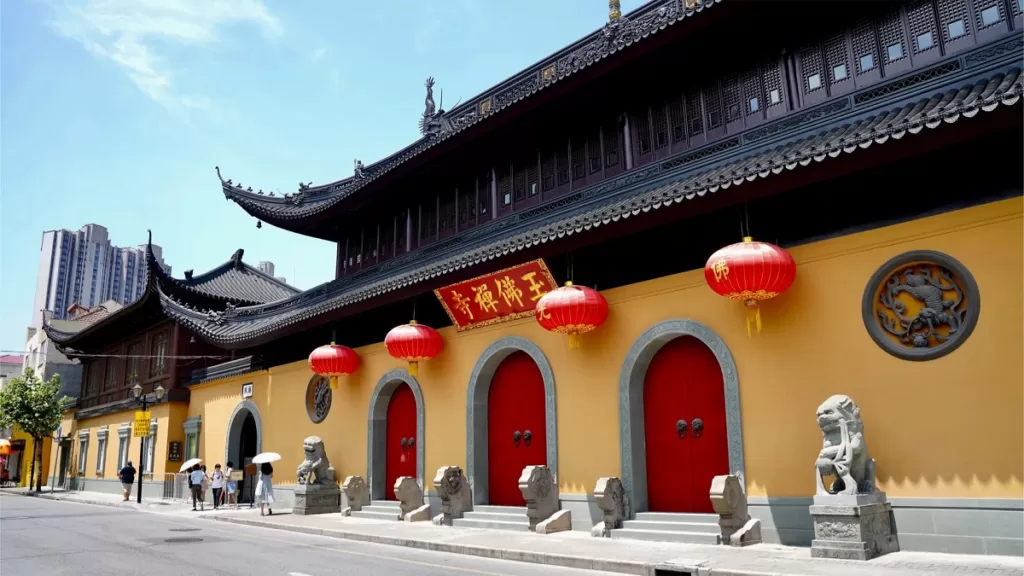

Situated in the bustling cityscape of Shanghai, the Jade Buddha Temple (玉佛寺, Yufo Temple) stands as a serene sanctuary amidst the urban chaos. Established in the 8th year of the Qing Dynasty’s Guangxu reign (1882), this temple holds a significant place alongside other renowned temples in Shanghai, such as Longhua Temple and Jing’an Temple. The current layout of the Jade Buddha Temple consists of two main sections: the front courtyard, which encompasses the original temple site, and the rear courtyard featuring a multifunctional building called Juequn Dali.
The front courtyard unfolds along a central axis, adorned with architectural marvels such as the grand archway, the Hall of Heavenly Kings, the Mahavira Hall, and the Wisdom Attainment Chamber (with the Jade Buddha Tower and the Scripture Hall on its upper floors). This section boasts a design reminiscent of Song Dynasty palace architecture. In contrast, the rear courtyard is home to the versatile Juequn building. Within the temple precincts, the cultural relics room houses a collection of precious artifacts from the Northern Wei, Tang, Song, Yuan, Ming, and Qing dynasties.
Notably, the Jade Buddha Temple gained prominence for housing two jade Buddha statues brought back from Myanmar by Master Huigen of Mount Putuo during the late Qing Dynasty. Interestingly, while Master Huigen originally acquired a total of five jade Buddha statues, he chose to leave two of them in Shanghai during his return journey to Mount Putuo.
The temple attracts a steady stream of worshippers, especially during the first and fifteenth days of each lunar month when devotees flock to offer incense. One of the temple’s notable events is the burning of the first incense on the first day of the lunar new year, drawing worshippers who eagerly wait outside the temple gates on New Year’s Eve, hoping that their wishes will be granted with the first incense of the year.
目录
- 基本信息
- 地点和交通
- History of Jade Buddha Temple
- Highlights of Jade Buddha Temple
- Map of Jade Buddha Temple
- Vlog about Jade Buddha Temple
- 从评论中总结出的有用提示
- 上海其他寺庙
基本信息
| 网站 | http://www.yufotemple.com/ |
| 预计参观时间 | 1-2 小时 |
| Entrance fee | 20 RMB for admission, and you need to pay an extra of 10 RMB to get into the Jade Buddha Chamber |
| 开放时间 | 8.00-16.30 on normal days. The open time may be brought forward to 6.00 am or 7 am on festivals and special occasions. |
| 电话号码 | 0086-021-62663688 |
地点和交通
Jade Buddha Temple can be found in the Putuo District, in the northwestern part of the city. It is easily accessible by public transportation and is close to several other popular tourist attractions, including the Shanghai Museum, the Shanghai Grand Theatre, and People’s Square.
巴士 Take bus No. 19, 206, 316, 328, or 738, get off at Jiangninglu Anyuanlu Stop, and you will be right in front of its East Gate
地铁 Take subway line 13, get off at Jiangninglu Station, turn left into Jiangning Road, and you will find the temple on your right-hand side after 240 meters. You can also get off at Changshoulu Station on Lines 7 and 13, but you have to walk a longer distance in this case.
自驾游: There is a parking lot to the south of the temple, at the intersection of Shangxi North Road and Anyuan Road. You can park your car there and enter the temple by the Southeast gate.
Railway: The temple is only 1.6 kilometers away from the Shanghai Railway Station. If you arrive in Shanghai at this station, you can walk there directly.
History of Jade Buddha Temple
The Jade Buddha Temple in Shanghai has a rich and fascinating history dating back over a century. The temple was founded in 1882 by a Buddhist monk named Huigen, who had brought two precious jade Buddha statues back from a trip to Burma. The statues, one seated and one reclining, are considered among the most important cultural relics in Shanghai, and they give the temple its name.
The original temple was destroyed during the Taiping Rebellion in the late 19th century, but it was rebuilt and expanded several times over the years, becoming one of the largest and most important Buddhist temples in Shanghai. During the Cultural Revolution in the 20th century, the temple was used as a factory and suffered significant damage, but it was eventually restored to its former glory in the 1980s.
Today, the Jade Buddha Temple is a thriving center of Buddhist worship, culture, and education, attracting thousands of visitors from all over the world every year.
Highlights of Jade Buddha Temple
The Mahavira Hall
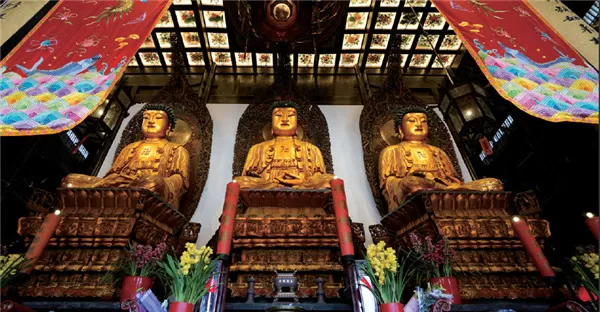
The Mahavira Hall serves as the central edifice in the Jade Buddha Temple, measuring approximately 30 meters in length and 25 meters in width. This two-story palace-style structure, echoing the architectural style of the Song Dynasty, radiates an ancient and solemn aura. At its core, the hall houses three majestic Buddha statues: Shakyamuni in the center, flanked by Amitabha Buddha and Bhaisajyaguru on either side. Seated on lotus thrones, these 4-meter-tall golden-clad statues exude serenity, casting a radiant and dignified atmosphere throughout the hall. Above Shakyamuni’s head, the ceiling features a vivid and captivating depiction of his birth, showcasing a swirling pattern with the playful imagery of his naked form and nine dragons spraying water for his ceremonial bathing – a charming and lively representation.
The Jade Buddhas
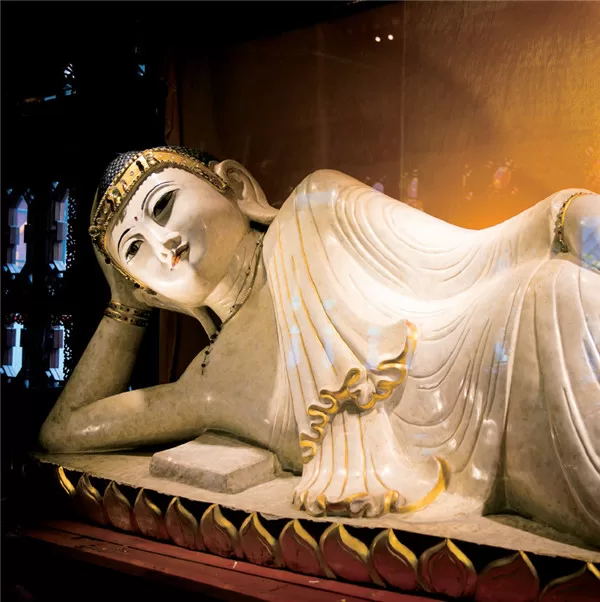
The Jade Buddha Temple houses two remarkable jade Buddha statues, each holding its own significance. The first, located within the Jade Buddha Tower, is a seated statue of Shakyamuni measuring 1.92 meters in height. Adorned with dazzling gold leaf and embedded gemstones, this Buddha is revered as the “treasure of the temple.” The Jade Buddha Tower’s ceiling boasts an additional 500 gold-plated Buddha statues, requiring a separate entrance fee of 10 yuan for visitors.
The second jade Buddha, housed in the reclining Buddha hall on the west side of the temple, is a 96-centimeter-long statue depicting Shakyamuni in a reclined posture, replicating the appearance of his passing at the age of 80. With a serene expression, the reclining Buddha rests on his side, supporting his head with his right hand. Across from the reclining Buddha, a recent addition, approximately 4 meters in length, was donated by Singaporean devotees, enhancing the temple’s spiritual and artistic richness.
The Vegetarian Restaurant
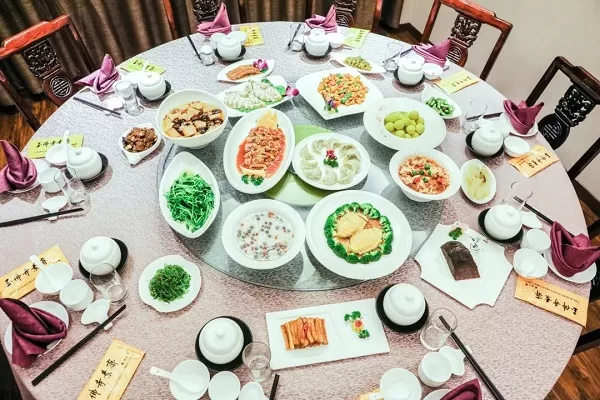
The Vegetarian Restaurant in the Jade Buddha Temple is a popular dining destination for both tourists and locals. As a part of the temple complex, the restaurant is dedicated to providing delicious and healthy meals that are in accordance with Buddhist dietary restrictions. This means that all of the food served here is vegetarian and does not contain any meat, poultry, fish, or eggs.
The menu features a range of dishes, including soups, stir-fries, rice dishes, and noodle dishes, as well as an assortment of snacks and desserts. The food is made with fresh, wholesome ingredients, and the chefs take pride in creating dishes that are both healthy and delicious.
Map of Jade Buddha Temple

Vlog about Jade Buddha Temple
从评论中总结出的有用提示
Try Vegetarian Noodles at the Vegetarian Restaurant: At the vegetarian restaurant inside Jade Buddha Temple, you can queue up to order vegetarian noodles priced between 25 to 30 yuan per bowl. They offer various options such as double mushroom noodles and arhat noodles, along with a selection of dim sum and ice cream.
Prepare Some Change for Donation Boxes: It’s customary to donate to the temple after your visit. You’ll find donation boxes in each hall, where you can contribute a small amount as a token of gratitude for the spiritual experience.
Be Cautious of Fortune Tellers: Before entering the temple, you may encounter strangers offering to read your fortune. It’s advisable not to trust them and politely decline their services to avoid any potential scams.
Visit the Coffee Shop Across the Temple: Across from the temple, there’s a popular coffee shop called Fangtan (方壇), known for its delicious coffee and elegant ambiance. It’s a great place to relax and enjoy a cup of coffee after exploring the temple.
Try Zen Tea: Adjacent to the Jade Buddha Hall, you’ll find a Zen tea stall offering a special tea called “Zhiyue Zen Tea” for 20 yuan per cup. During winter, they serve a warming drink made with ginger, jujube, honey, and tangerine peel, perfect for chilly days.
上海其他寺庙

上海孔庙--令人肃然起敬的文化古迹
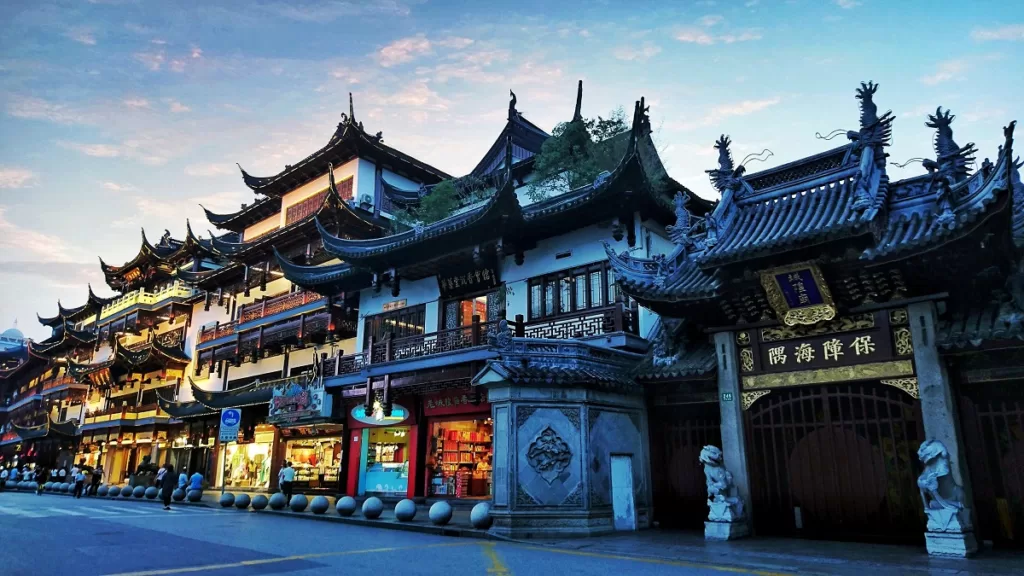

真如寺 - 唐代寺庙